Annual Oration 1941
By A. Warren Stearns, M.D.
Know then thyself, presume not God to scan;
The proper study of mankind is man.
Pope: Essay on Man (Epistle II).
The place of the physician in the community has been fixed by long years of tradition. In primitive society, and in remote history, he was a sort of conjurer or magician called upon in times of great calamity or dire distress as an intermediary between the supernatural and the natural. He has developed throughout history, oftentimes somewhat ahead of contemporary civilization, and has emerged from the realms of magic, superstition, conjecture and belief, largely through the channels of biology, until today he stands as the exponent of the scientific method as related to human welfare. For many years, through the ever unfolding knowledge of anatomy, physiology and pharmacology, he sought to alleviate suffering by treating the ills with which he found his patients afflicted. His task had largely to do with the treatment of individuals. As medicine took on more and more of a scientific aspect, it is only natural that there should have developed special interests, and thus we find certain physicians whose propensities led them to devote their lives more and more to research and scholarship; they have tended to associate themselves with medical schools. Others very early saw a gain to human welfare in preventive medicine; they therefore occupied themselves in developing the field of sanitation and have tended to occupy posts in the public service. Still the great mass of physicians plied their trade by ministering to the suffering of afflicted individuals.
Latterly, throughout the field of science there has been a great interest in chemistry. The clearer understanding of certain physiologic and pathologic processes through chemical research, together with the remarkable advance in chemotherapy, has tended to put chemistry very much in the foreground, to the great good of individual sick persons, as well as to society at large. Likewise, through the development of anesthesia and asepsis the field of surgery has grown to a degree of perfection and usefulness beyond the dreams of the most enthusiastic but a few years ago. Let us hope, indeed we may expect, that medical scholarship, as exemplified in the schools, will continue to develop. Certainly the greater and greater participation by governmental departments in sanitary science and preventive medicine carries great promise, while specific therapy and surgery show no evidence of a slackening pace.
Yet man does not live in a vacuum. He has, as Cannon has so ably pointed out, an internal and an external environment. He is a reacting organism continually played upon by environmental stimuli, and his social status has many important medical implications.
Slightly less than two hundred years ago, a wave of humanitarianism came upon Western civilization. Ruthless, predatory man paused for a moment in his egotistic career and cast a pitying glance at his less fortunate brother. He found a substantial component of human society utterly degraded, the depths of degradation being expressed by the jail, the poorhouse and the asylum. Strong hearts and courageous souls sought to alleviate the condition of these persons, and substantial progress was made through the improvement of public institutions. Very early there appeared an important medical component in this undertaking, and doctors were frequently found in positions of leadership in this field of human endeavor. At first expressed through better sanitation, more humane treatment and better care of the sick, this medical interest gradually became focused on the personalities of the individuals and their behavior in society. From this lowly origin has developed the specialty of psychiatry, and we now think of many of these submerged persons in terms of mental disease, defect or peculiarity.
The study of these patients by modern technics of physical examination reveals very little. Nor were the majority of their ills capable of attack by either specific therapy or surgery. It was soon found that a study of the organism was quite incomplete without a knowledge of the situation in which it was placed. Psychiatry has accordingly tended to some extent to be a bridge over which medicine has passed into the social sciences. Many of the data of the social sciences were found to be quite sterile so far as their biologic content was concerned, but gradually there has developed in the fields of sociology, psychology and psychiatry a meeting point in the behavior of the individual, and a concern over the situation in which he is placed.
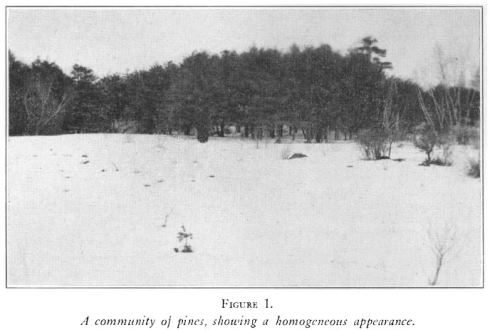
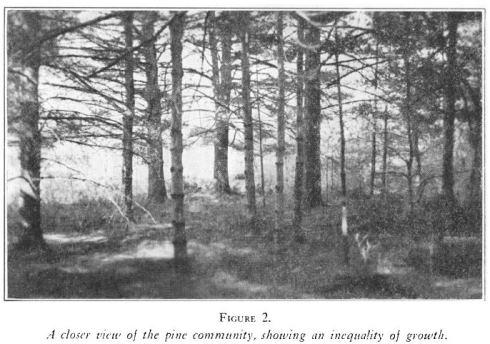 If the problems of medicine are fundamentally biologic, it is important as a means of gaining perspective that the elementary principles of living matter be known, and that natural law be kept continually in mind. It is perhaps well to begin our study with some simpler form of life. The pine tree may be taken as an example. If we view a community of pines from a distance, the whole group appears to be a homogeneous mass of verdure, but if we examine it more closely we find it to be made up of individual trees. The most superficial scrutiny shows a gross disproportion in the growth of these trees. Some appear to be sturdier and healthier than their comrades. Their growth has been greater, and they obviously get more sunlight from the air and water from the ground than their less fortunate fellows. The stronger ones grow to the hurt and even to the death of surrounding trees. Yet we do not express this greater growth in teleological terminology, or impute hostile motives to the more successful tree. We speak of the survival of the fittest, but do not imply a conscious attempt to destroy one another. This condition can better be expressed in functional terms, as follows: There is a propensity on the part of all trees to grow, and it is a function of certain elements in the trees to get all the sun and water that they can. As a result of the carrying out of this function, growth takes place. The better endowed trees prosper disproportionately. The effect on the other trees is secondary and incidental. Whether we subscribe to Darwin's evolutionary theory of a constant betterment in nature, to Spengler's theory of a rhythmic rise and fall for better or worse or to Sorokin's concept of a cycle of cultures is not important. Throughout Nature there is a tendency on the part of organisms to develop and grow. I take it that no one will dispute the contention that this principle applies to man as well as to pine trees. Yet, when we study the pine tree our attitude is relatively dispassionate and correspondingly less biased, whereas the study of man immediately involves the operation of factors not present when judging the rest of Nature. Among these factors are the ethical, humanitarian and moral. Nevertheless, this does not invalidate the principle of Darwin's law of the survival of the fittest. It is natural for man to grow. There are elements in his make-up that function to get the wherewithal by which growth takes place. The hurt, if any, to other elements in society is secondary and incidental. The growth of certain persons is bound to be greater than that of others. However this may be, it is a fact that the operation of natural law is as if the conduct of the individual in relation to others were purposeful. The selfish and predatory man operates in society as if he were determined to dominate his fellows, and, in certain cases, to destroy them. For this reason, social engineers must take cognizance of the hurt, if any, done to society by the unrestrained operation of natural propensities in superior individuals. Likewise, it must take cognizance of the frailty, folly and incapacity of others who, though not purposely trying to destroy themselves, act as if such were their purpose.
If the problems of medicine are fundamentally biologic, it is important as a means of gaining perspective that the elementary principles of living matter be known, and that natural law be kept continually in mind. It is perhaps well to begin our study with some simpler form of life. The pine tree may be taken as an example. If we view a community of pines from a distance, the whole group appears to be a homogeneous mass of verdure, but if we examine it more closely we find it to be made up of individual trees. The most superficial scrutiny shows a gross disproportion in the growth of these trees. Some appear to be sturdier and healthier than their comrades. Their growth has been greater, and they obviously get more sunlight from the air and water from the ground than their less fortunate fellows. The stronger ones grow to the hurt and even to the death of surrounding trees. Yet we do not express this greater growth in teleological terminology, or impute hostile motives to the more successful tree. We speak of the survival of the fittest, but do not imply a conscious attempt to destroy one another. This condition can better be expressed in functional terms, as follows: There is a propensity on the part of all trees to grow, and it is a function of certain elements in the trees to get all the sun and water that they can. As a result of the carrying out of this function, growth takes place. The better endowed trees prosper disproportionately. The effect on the other trees is secondary and incidental. Whether we subscribe to Darwin's evolutionary theory of a constant betterment in nature, to Spengler's theory of a rhythmic rise and fall for better or worse or to Sorokin's concept of a cycle of cultures is not important. Throughout Nature there is a tendency on the part of organisms to develop and grow. I take it that no one will dispute the contention that this principle applies to man as well as to pine trees. Yet, when we study the pine tree our attitude is relatively dispassionate and correspondingly less biased, whereas the study of man immediately involves the operation of factors not present when judging the rest of Nature. Among these factors are the ethical, humanitarian and moral. Nevertheless, this does not invalidate the principle of Darwin's law of the survival of the fittest. It is natural for man to grow. There are elements in his make-up that function to get the wherewithal by which growth takes place. The hurt, if any, to other elements in society is secondary and incidental. The growth of certain persons is bound to be greater than that of others. However this may be, it is a fact that the operation of natural law is as if the conduct of the individual in relation to others were purposeful. The selfish and predatory man operates in society as if he were determined to dominate his fellows, and, in certain cases, to destroy them. For this reason, social engineers must take cognizance of the hurt, if any, done to society by the unrestrained operation of natural propensities in superior individuals. Likewise, it must take cognizance of the frailty, folly and incapacity of others who, though not purposely trying to destroy themselves, act as if such were their purpose.
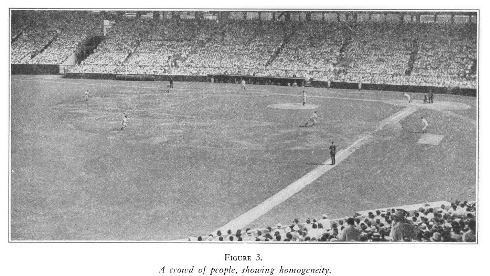
One fundamental difference between the pine tree and the human being is the effect of growth by the individual on its fellows. With the pine tree, although the community may offer more or less mutual aid through soil conditioning, protection from hurricanes and otherwise, this is not so pronounced as in the human being. Ordinarily, where the human being grows to great stature he provides opportunities for similar, even though less extensive, growth on the part of many associates. In fact, the less capable people are often quite dependent for their status on the initiative, energy and creative genius of those who are superior. When this is done with candor, good faith and fairness, the superior persons may be said to be performing a service to their less well-endowed associates. On the other hand, there is a line beyond which this becomes a disservice and is called exploit. Veblen designates the means of exploit as force and fraud. If we accept this definition, any use of another's talents that embodies force or fraud is exploit and may be considered a disservice. Obviously, if the government essays to referee our mutual relations, the latter is the field in which it should operate, always being careful not to apply the police technics used to curb exploit for the purpose of interfering with real service. Whether or not the employment of one person by another is service or exploit is a delicate question. Attempts have been made to define it on the basis of wages and hours of work. In actual practice this may have very little to do with determining the distinction. Employment of a handicapped person at a low wage may be a great service to both the individual and the community.
If this same type of scrutiny is applied to society, in the mass, human beings appear to be very much the same. Their basic physiologic striving is identical, and we often speak of society as if it were a homogeneous mass of identical individuals. Here again closer scrutiny shows a stratification. By whatever standard we measure individuals, whether political, economic or social, each falls in a rather definite place in a great social hierarchy. According to Sorokin this is true of every society that has been the object of scrutiny.
Leveling processes have been tried from time to time, but have always ended in disaster. Sorokin speaks of the social structure as a cone, the profile of which, although it fluctuates somewhat from time to time, tends to be the same. During good times, the rich grow richer, but every element of the cone shows a similar benefit. The general character of the cone remains about the same.
Again, if we scrutinize this social mass we note a constant mobility. That is, we find a tendency on the part of certain organisms to grow out of proportion to certain other elements and to rise to a higher and higher level. Certain other elements either remain stationary or tend to settle out, forming a vast sediment of relative immobility at the lower levels. To be sure, certain persons, through the wisdom of trustees, are able to remain more or less immobile in the upper stratums for a while, but a constant tendency is found to revert ultimately to lower levels.
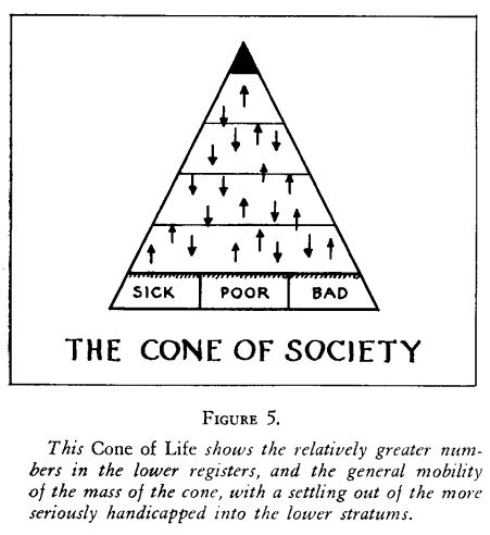
Much might be said concerning the factors making for growth. A superficial study of those elements tending to rise seems to indicate the presence of such attributes as strength, intelligence, industry and virtue. Perhaps the generation of energy on the part of the individual is of first importance. If we break down the behavior of the individual into its elementary dynamics we find first a striving on the physiologic level. This has to do with the basic and more or less automatic factors in life. These are carried out quite unconsciously and, of course, are purely selfish. To a lesser extent, human behavior is conditioned by social pressure. Such factors as morality, prudence and cautiousness tend to be in this social category, and, therefore, are to quite an extent dependent on indoctrination. Lastly, a greater or less amount of intellectual guidance tends to modify and direct the operation of the two former forces. Here again, people differ in the basic physiologic drives impelling them forward. They also differ in their responsiveness to social pressure, and, lastly, they vary tremendously in intellectual equipment.
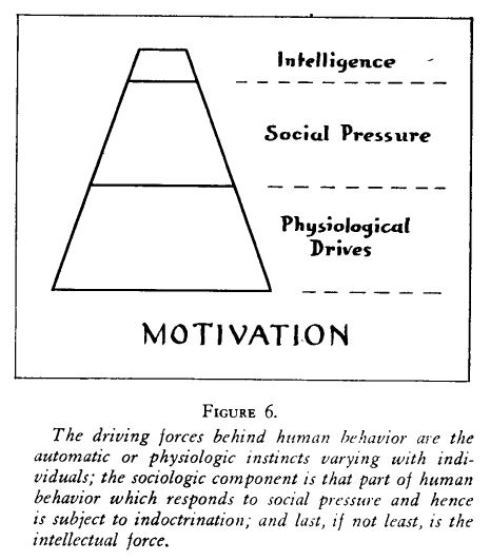
There is still much work to be done in understanding the factors of social mobility, but it is possible to study the composition of the relatively immobile sedimentary elements in society because such persons tend to come under public scrutiny, and their misfortunes become matters of public record. A gross-specimen view seems to indicate an almost pure culture of social disease at the base of the social cone. They have been classified by state departments and institutions through the administrative officers of society as the sick, the poor and the bad. It is true that we find sickness, poverty and crime throughout the whole of society. The sediment differs largely in that it is quite a pure culture of these evidences of social sickness. If we examine these categories a little closer we find a marked degree of overlapping among them. The sick are often impoverished, the poor are often bad, and vice versa. I have been told that 68 per cent of the people admitted to a large poorhouse had previously been in jail. Large percentages of criminals are known to have ill health, and the whole realm of disease is often closely related to the other disabilities. Until recently a large municipal hospital would not accept cases of venereal disease to its wards. So that all we can say of these three groups is that certain individuals are preponderantly sick, and, therefore, their illness is what calls for first attention. The others are preponderantly poor or bad. In the field of etiology, their difficulties appear to spring from the same sources. They all tend to be handicapped, each one with a large medical component. Therefore, it seems axiomatic that medicine cannot serve with maximum social benefit without taking cognizance of these matters. Furthermore, the terms sick, poor and bad are all relative. We can represent their degree as with a thermometer. At the top it is generally recognized as hot, at the bottom as cold, and yet the exact position where cold ceases and hot begins is relative. If one goes from a room with a temperature of twenty into a room at fifty, he says it is warm. Yet if he had previously been in a room with a temperature of seventy, it would seem cold. Likewise, there is no level at which one may be said to be good or bad, rich or poor, well or sick. For this reason it would seem fallacious to be too arbitrary in setting standards. A person with psoriasis may be said to have a chronic, incurable disease, yet he may suffer very little disability from it. Similar observations might be made concerning the poor and the bad.
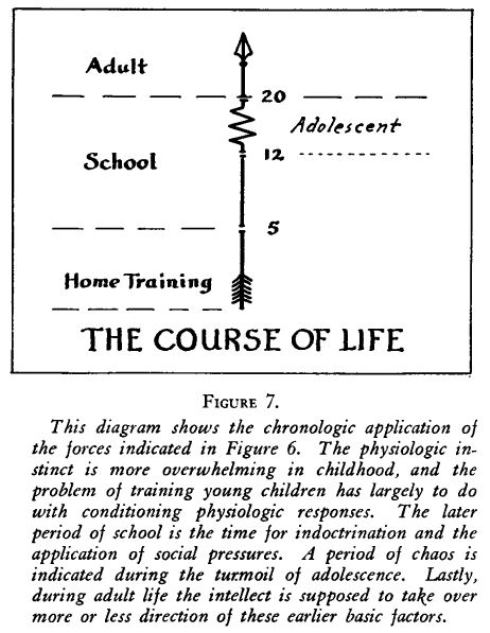
The number of dependents in a community is a variable that fluctuates between certain levels. Under natural law, during prosperous times, all stratums of society are benefited, even the insane. Likewise, during bad times all suffer. Those at the upper levels, of course, have more fat on which to live, and, therefore, suffer less in the essential matters. Bad times usually lead to remedial efforts on the part of society to alleviate the suffering of those whose situation is most desperate. Although in theory, the roof of the relief load is governed by the necessities of the individual, in practice, dependency is artificially expanded. The tendency to exploit is not peculiar to any class of people, but is a component of every person. Normally, during hard times, social necessity creates a pressure, which induces the less well endowed to work harder at longer hours and lower wages. It may be well for government acting as a referee to see to it that such persons are not exploited by their stronger fellows. However, if such attempts, carried out horizontally, are too beneficent, there is apparently no limit to the rising height of the relief load. When the relief load becomes large enough, it too becomes the object of exploit by politicians, social workers and government officials. The politician exploits the distress of these people for purposes of votes, the social worker and government official because the size of their jobs tends to enhance their prestige as well as to increase their salaries. Incidentally, the same factor of growth enters this situation if those having charge of dependent groups happen to be successful promoters, and the growth of the individual and of the problem takes place pari passu. Furthermore, there is some ground to believe that it is futile to set an arbitrary standard of living. In fact, the use of the word "standard" is unjustified. There can be an average level of living, but there can be no standard arbitrarily set because of individual differences. What seems a pittance to one man is like a fortune to another. There has recently appeared a discussion of this problem in which it was stated that 66 per cent of the population were living on a substandard basis. This is like saying that the average is below the average. It may be a mistaken kindness on the part of those in the upper level to set the satisfactory level of living at a point higher than that at which 66 per cent of the people can sustain themselves. Furthermore, this immediately provokes the question: Can a minority of the people sustain a majority at a level of living higher than they are able and willing to sustain themselves? If the answer to this question is, Yes, another question is immediately provoked. How small a minority of the people can sustain how large a majority at a level higher than they are willing and able to sustain themselves? To be sure, this seems simple enough to the levelers through the field of taxation. However, in the imperfect state of the human mind at the present time, it appears that there is a point in taxation for the purpose of assisting the less well endowed at which the better endowed is discouraged or, at any rate, deterred and inhibited in his capacity to grow, thus invoking the law of diminishing returns. Society cannot lift itself by the boot straps any more than the individual can.
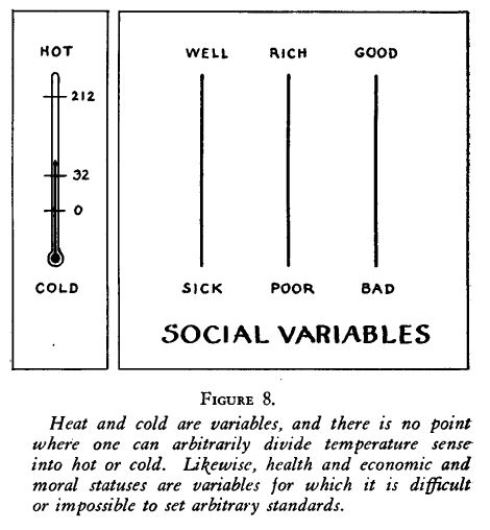
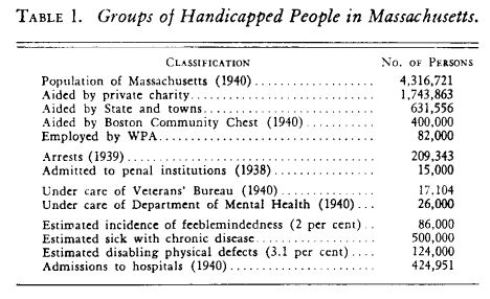 To present more specifically the problem of medicine concerning these matters, it seems appropriate to break the groups down further and set them up in new categories as follows: the child; the aged; handicapped classes; the insane; the feebleminded; the neurotic; the disordered personalities; drug and alcohol addicts; and the physically diseased.
To present more specifically the problem of medicine concerning these matters, it seems appropriate to break the groups down further and set them up in new categories as follows: the child; the aged; handicapped classes; the insane; the feebleminded; the neurotic; the disordered personalities; drug and alcohol addicts; and the physically diseased.
The Child
The child is a relatively helpless person. Wherever evidence of social disease is found, there is always an excess of children. The law does not recognize the child as legally competent until he is twenty-one years old. He cannot vote, hold title to real estate, inherit property, incur debts or marry. Thus, we have the traditional dependence and incapacity of the child, and among the first efforts in the field of social welfare were attempts to protect children.
Population studies estimate about 35 per cent of the inhabitants of Massachusetts as under twenty-one years of age. This would place the number at approximately one and a half million. General health measures appear to be fairly well organized, and tremendous strides have been made in control of infectious disease. However, there are social responsibilities that it is imperative to recognize in connection with children. Some have competent but many have incompetent parents. The doctor certainly has responsibility in this field. In the first place, he brings the child into the world. He treats the various ills to which children are peculiarly susceptible, and, in matters of nutrition and growth, he takes the initiative and leadership, frequently being obliged to hold parents to their task. In the field of immunization the individual doctor has not taken so much initiative as might be desired. Who could better participate in the education and training of the child than the one who has had so much to do with the other phases of his upbringing? There is a tendency on the part of parents to make pets of their children, and to be lax in the disciplinary requirements of their training. The development of inferiority and paranoid reactions may well be the result of parental bias and leads to unhealthy attitudes of mind. Thorn has many times shown the relation between faulty habits in young children and later maladaptations. So much has been said concerning this matter that it hardly seems necessary to reiterate. Furthermore, from time immemorial the minds of young people have been prepared for the struggles and vicissitudes of adult life by the promulgation of certain attitudes. The competitive elements in school marks, organized play and other attainments may be used in such a way as to be very helpful, or they may be exploited to the injury of growing children. The doctor should not assume these tasks alone, but should do his share along with parents, religionists and teachers. Fortunately, the majority of children are only temporarily incapacitated, for, with the development of maturity, they soon emerge from the sedimentary stratum and take their place at whatever level in the social scale their capacity to grow places them.
The Aged
At the end of the scale we have the aged. Much has been written and said concerning the ever increasing number of the aged. It is estimated that at the present time about 8 per cent of the population is over sixty years of age. This gives a population of approximately 350,000 old people in Massachusetts. We do not know how many of these are dependent or what they are doing. Some 80,000 are receiving old-age assistance, and the number is increasing each year. Many new bills are before the Legislature to lower the age of eligibility and to increase the amount paid to each person. Much that has been said concerning the situation of the child might apply with equal appropriateness to the aged. Likewise, conditions make it increasingly difficult for the aged to support themselves in ordinary competition with young, vigorous persons. They are more susceptible to illness, probably more prone to accident, and in many ways a greater liability than younger people. The grant of a special form of relief to the aged has tended to weaken the pressure on children to care for their parents, and has likewise reduced the incentive on the part of the older persons to carry on. Innumerable private institutions have grown up depending on the helplessness of these aged persons for their support. They are also particularly vulnerable to exploit.
Medicine must shoulder its share of the responsibility for the care of this group, and should furnish leadership in the field of social engineering as applied to the aged. Obviously, if they were all pensioned, the cost would be almost prohibitive. It also seems true that the vast majority of older persons would be happier pursuing some gainful occupation, and maintaining thereby their self-respect and dignity. There is a great disproportion between chronologic and physiologic age about which more should be known. Certainly a program for aged persons, preventing the indignities and deprivations of neglect, guarding against exploitation, and yet giving them an opportunity for a full, satisfying life commensurate with their abilities, needs the medical profession badly. The beginning of a specialty of geriatrics augurs well for the future. When an aged person is found in the sedimentary zone of society he is usually there for good, and most of the aged grow increasingly unable to support themselves at levels above dependency.
Handicapped Classes
There are many groups in our society against whom great odds are arrayed.
Approximately half the population of Massachusetts is female. Ordinarily, but 25 per cent pursue gainful occupations. They are susceptible to certain disabilities not common to males. When they work they receive a smaller salary, and are still quite dependent on male initiative to keep their status in society. For this reason, the capacity of the female to grow is limited as compared with the male, and they are therefore found in certain dependent positions out of proportion to their occurrence in society. This has been recognized by the provision for mothers' aid.
More than half the population of Massachusetts are foreign born. Coming to our shores from a foreign land has been a great stimulus to certain persons. By hard work, long hours and low wages they have advanced their status till at the present moment our colleges are literally overflowing with the children of immigrants. Alas, so are our prisons. Here again, competition is not even. The foreign born tend to receive lower wages than the American born and have less education. They are found out of proportion to their incidence in society in prisons, hospitals and poorhouses. An equal degree of success by a foreign-born person means greater ability, strength or industry. When they fail, they lack the resources to carry on and are consequently found in a sedimentary nonmobile stratum in excess to native born.
The Negro, largely by virtue of the amount of pigment in his skin, is a handicapped person in our state. When 25.9 per cent of the native white population of Massachusetts were unemployed, 33.9 per cent of the Negroes were out of work. They are found in hospitals and other institutions out of proportion to their incidence in society. Of a certain class of criminals admitted to the Charlestown State Prison, 10 per cent are colored, whereas their incidence in the general population of the state is but slightly over 1 per cent. This tends to place them at a lower level in society, to concentrate them in squalid districts, and thus increases their susceptibility to poverty, disease and vice.
Good social engineering on the part of the medical profession cannot equalize the opportunity for all, but it can recognize the situation and do its part toward a rational program for prevention and cure.
The Insane
Nobody knows how many insane there are. The only figures we have are state hospital admissions, but there is ample evidence of the wide distribution of mental disease throughout all stratums of society. Those of us who are practicing psychiatry in the city, and attending large clinics, are in daily contact with a considerable number of persons with definite mental disease, yet of such a nature that their families are able to care for them. This applies particularly to the aged and to persons with mild depressive psychoses. Many of the inmates of nursing homes and sanatoriums are technically insane, although not carried on the books as such.
In the early days of our state-hospital system, a hope was set forth that, if persons with mental disease could be brought in earlier and would stay longer, as high as 84 per cent of them could be cured. Upon this hope, to some extent, the state hospital system has developed until we now have approximately 30,000 under care in Massachusetts. Some have recoverable diseases, and their ultimate discharge can be predicted at the time of admission, but with the vast majority we are dealing with deteriorating processes, and they are looked on largely as problems for custodial care. Once the burden has been lifted, the family is very loath to assume it again. The only limit to the state hospital load up to the present time is the number of beds available.
This problem first of all calls for investigation. Already there appears to be some diminution in the number of persons developing mental disease because of syphilis, but this barely touches the surface. The state-hospital system has already been expanded to a point where great resistance toward its further extension is met from tax-minded people. It has been suggested that a considerable number of inmates at present in state hospitals could be cared for in the community under proper supervision. For a number of years people have been encouraged, and almost exhorted, to send patients to hospitals for mental disease early. Perhaps we are reaching a stage where some selection must be made, and the medical profession must equip itself to supervise intelligently large numbers of persons with mental disease in the homes of the community. It is obvious that the vast majority of persons with frank mental disease are thoroughly disabled and bound to be in the sedimentary stratum of society.
The Feebleminded
Certain children do not develop intellectually and are called feebleminded. There may be some debate as to exactly the level of intelligence that should stamp one as feebleminded, but the helplessness of this group is universally recognized. Conservative estimates place the number of feebleminded in Massachusetts as around 2 per cent. If this is true, there are at least 86,000 feebleminded in Massachusetts. Approximately 5000 of these are in institutions for the feebleminded. One hundred years ago, a beginning was made toward training the feebleminded, the idea being that with special training they would develop and take their place as normal citizens. Unfortunately, this fond hope has not been realized. The number in the institutions, as set forth in a recent study, indicates an ever-increasing age and a diminished discharge rate. At the present time 57 per cent of the population of the schools are over twenty years of age, that is, beyond the age at which education is usually successful even in healthy persons. This report, which is the latest statement concerning the problem of the feebleminded in Massachusetts, makes no attempt to solve it but ends with a fervent plea for one more institution. If the proponents of this measure should be successful, the total result would be that instead of their being 81,000 feebleminded abroad in the community, there would be 79,000. This does not seem a sufficient end. Here is a challenge to the medical profession. At the present moment, we have little to offer between 100 per cent incarceration in a school for the feebleminded and 100 per cent neglect in the community.
Although the general helplessness of the feebleminded is recognized, they are held up to many responsibilities. They are entitled to vote and to buy liquor, and are called on to support themselves. The average doctor pays little attention to this group. There are some whose parents are thoroughly competent and able to protect and provide for them, but the vast majority are turned loose and do much to augment our social perplexities. The number of feebleminded in jails, poorhouses and hospitals is proportionately large. When the physician is consulted, he shakes his head, speaks vaguely of the state schools and their overcrowding, and often has little more to offer.
Now there is a level at which many of the feebleminded can lead independent lives. In fact, of all those discharged from the state schools 15 per cent are considered capable of self-support, and 14 per cent are capable of partial self-support. Perhaps, the group sent to the school tend to be the more troublesome cases.
Certain developments in society during the past few years have made it increasingly difficult for handicapped persons to pursue gainful occupations. These militate particularly against the feebleminded, and may therefore be discussed here. In the first place, the change from an agrarian and rural to an urban community presents problems. Eighty-nine per cent of the population of Massachusetts now dwells in cities. The transition from large, independent households to tenement dwellers makes it increasingly difficult for a family to develop the talents of a feebleminded person, and especially, the field for productive labor on the family farm is well-nigh closed. Likewise, the control of certain people by workers' organizations tends to exclude the feebleminded and other handicapped persons. Again, the setting of a minimum wage tends to exclude those who are not competent to earn that wage.
To raise the standard of living of certain of the lower stratums of society, ignoring the element of handicap among such persons, minimum-wage laws have been set up. It has been perhaps rather naively hypothecated that if a minimum wage was set in an industry the lower elements in society would be more or less automatically introduced to a higher scale of living. I have been unable to procure extensive data on this matter, which would seem to be elementary, and yet there is some reason to suppose that the setting of a minimum wage automatically discharges those persons who are not competent to earn this wage, thereby lowering their scale of living—in fact, reducing them to a welfare level, the jobs at higher wages being taken by persons coming in from horizontal positions who are capable of earning this wage. This is an example of an attempt to solve a social problem on theoretical grounds without adequate preliminary research. Lastly, the carrying of insurance against industrial accidents has led to a medical examination of applicants for jobs, and thereby tends to exclude any who may be considered accident prone. All these things have limited the fields of endeavor open to handicapped persons, especially the feebleminded.
The medical profession should furnish leadership in providing for the approximate 80,000 noninstitutionalized feebleminded. Obviously, it is futile to think of institutional care for this vast throng for the reasons given above. The feebleminded tend to constitute a substantial part of the immobile elements in society, remaining a more or less permanent part of the sedimentary stratum and furnishing more than their share of disease, poverty and crime.
The Neurotic
Wherever large numbers of sick persons are found, there is an enormous amount of functional nervous disease. Estimates in large clinics, and in general practice, have run as high as 35 cent. This per group is ill-defined. Gradually medicine has come to look on their trouble as in the emotional field, yet they run the gamut of clinics, have many operations, and are a very great load on organized medicine. If wealthy, they are received enthusiastically by the practicing physician, but they are looked on with consternation in the free clinics. Their difficulty is perhaps situational to some extent, and many of them appear to be mixed medical and social problems. Welfare lists contain the names of many persons who at one moment are considered malingerers, and another as afflicted with some physical disease. Although many psychologic and physiologic studies have been made on this group in the last few years, there are still inadequate data as to the natural history of such illnesses, and we are still lacking a good statement as to their place in the whole medical scheme of things. These illnesses tend to be chronic and disabling, and therefore frequently place their victims in the dependent group.
The Disordered Personalities
This group occupies a vague zone in the social hierarchy and is still ill-defined by the medical profession. It has to do with those persons who, through personal peculiarities, are unable to adjust and adapt themselves to the requirements of society, and so become social problems in one way or another. The morbidly contentious find it difficult to obtain employment. They are continually agitating, and nobody wants them. They are frequently found on relief, in prisons and even in hospitals for the insane. The inadequate personality often gives up without a struggle and is feebly resistant to alcohol, and the emotionally unstable are often incapable of sustained productive effort. This group not only forms an important component in definite social disorders, but makes up a large number of those who are found in clinics appearing on the surface as neurotic. Needless to say, many of these persons appear in the sedimentary stratum.
Psychiatrists have expressed a belief that if these individuals were properly handled as children much of their difficulty in adult life might be avoided. Whether this is true, experience alone can tell. Nevertheless, it is true that the understanding physician who has an attitude of detachment is a great help in handling such cases. There is a place for each one of these people in society, if such a place can be found, but without skilled advice and understanding, they form one of the most turbulent and distressing factions with which we have to deal. There is no estimate of their number except to say that it is very large. One study set the percentage of the inmates of a large prison to be classified as personality disorders as very high.
Drug and Alcohol Addiction
Addiction to habit-forming drugs, including alcohol, has long been considered a medical problem, and, in the past, there have been many programs under medical stimulus and leadership attempting to attack this problem in an intelligent way. We have no census of alcoholic patients, but every index tends to show the load to be tremendous. There are approximately 84,863 arrests in Massachusetts every year for drunkenness. Thirty-two per cent of the patients admitted to the state hospitals are said to be intemperate. Alcoholism has been shown to be a very large component in the admissions to the Boston City Hospital.
There is no more discouraging problem with which to deal than that of alcoholism. The police handle the same cases over and over again. Certain persons have literally hundreds of sentences to jails and houses of correction. At the present moment, although there has been very recently a vigorous attempt to promote attention to this group, there is no state-wide program for prevention or cure, nor is there an adequate meeting of the minds of police, welfare and medical authorities. Quite a bit of the beneficent effort to raise the level of living of certain of the dependent groups is almost entirely vitiated through diversion of relief from the home to the saloon.
The drug problem is similar, but, of course, very much less flagrant. A surprising number of those who fail to meet their obligations in life are alcoholic and get into the sedimentary immobile stratum of society.
The Physically Diseased
I shall not attempt a wide discussion of the social problems of the physically ill, since much has been written on this subject of late. There are many data to indicate a greater incidence of disease among persons in the low-income groups. There has been a suggestion from some sources that ill health is due to inadequate medical care. This is a glorious tribute to the efficacy of medical practice, but has little basis in fact. It is well known that much of the reduction in disease has been due to sanitary measures, and that a relatively small amount has been due to curative medicine. Sanitation is almost entirely, at the present time, in the hands of the government, and the work of the practicing physician is largely in the field of curative medicine. However, there is a social component in the realm of physical disease that offers adventure in a somewhat new field.
It is estimated that 39 per cent of the population have some form of chronic disease that is disabling. Likewise, it is estimated that 3.1 per cent of the population are crippled to a point of being disabled. Then, the blind and the deaf should be added to this total. As with the others, modern social trends have militated against the possibility that these individuals will sustain themselves, and it has tended to make the problem social as well as medical. The well-known tendency of certain persons with minor disabilities to exploit their illness as a means of gain should be noted. The rehabilitation of disabled persons, the organization of co-operative workshops where they may pursue some sort of gainful occupation, and the breaking down of prejudice, as well as the keeping up of the morale of handicapped persons, need medical participation.
One important group is that of the epileptic. It is estimated that 0.17 per cent of the population have occasional convulsions. Recent developments have shown that a large number of epileptics can be kept symptom-free under medication. The others find it difficult to sustain themselves and need great ingenuity in planning special programs.
The attitude of different persons toward disease is a well-known variable. One person losing a phalanx on the fifth finger tends to exploit this disability and retire from active duty, whereas another person puts off until too long, cutting down on vigorous effort.
* * *
From the above it would appear that throughout Nature there is a tendency on the part of individuals to form themselves into a social hierarchy according to their capacity. Likewise, there is a level at which survival is precarious. In human society, the destruction of the less capable is prevented by the efforts of the more capable. The least capable are handicapped by sickness, poverty and vice, and it is the task of organized society to care for them.
This is, in the main, a clinical problem calling for the use of the scientific method, that is, the method of diagnosis as a preliminary step to treatment. There are extensive and intensive methods by which the problem can be attacked, analogous to sanitation and salvage in medicine. The medical profession has great opportunities as well as obligations in dealing with these matters since a professional personnel trained in scientific methods is available, and since, because of overlapping between these groups, it is inevitable that physicians participate in the solution of these problems.
_______________
Stearns, A. Warren. "The Role of the Physician in a Competitive Society." New England Journal of Medicine 224, no. 21 (1941): 879-90.
View all Annual Orations
